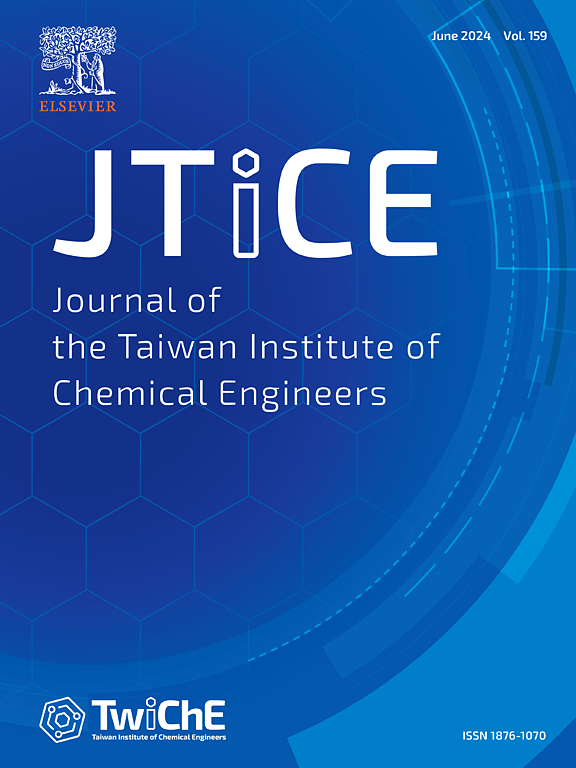Bioinspired synthesis of Fe2O3 nanoparticles uing Rosa Rugosa flower extract and their application as a potent alternative disinfecting agent against waterborne pathogens within wastewater management
IF 5.5
3区 工程技术
Q1 ENGINEERING, CHEMICAL
Journal of the Taiwan Institute of Chemical Engineers
Pub Date : 2025-03-13
DOI:10.1016/j.jtice.2025.106079
引用次数: 0
Abstract
Background
The serious health dangers associated with waterborne microorganisms have prompted research into substitute disinfectants.
Methods
In this work, the ferric oxide nanoparticles (Fe2O3 NPs) were produced in an green appraoch using Rosa rugosa cv. Plena (RP) extract and evaluated its antibacterial and antibiofilm activities against some pathogens. The synthesized Fe2O3 NPs were characterized via several techniques, namely UV–Vis, XRD, TEM, average particle size, zeta potential and SEM-EDX. Furthermore, the effectiveness of phyto-synthesized Fe2O3 NPs as a possible disinfectant against common aquatic infections was examined.
Significant findings
The data illustrated the preparation of Fe2O3 NPs with small size (67.77 nm). The minimum bactericidal concentration (MBC) of the synthesized Fe2O3 NPs against the target pathogens were measured, which showed encouraging inhibitory effects, especially at 2xMIC doses. The bacterial species of E.coli was more susceptible to Fe2O3 NPs with MIC 62.5 ± 8.3 μg/mL, while for Listeria monocytogenes, MIC value was 250 ± 15.6 µg/mL. Time-kill kinetics revealed the complete inhibition of bacterial growth within 100 min at 2 × MIC concentrations, while biofilm removal tests showed >90% inhibition at concentrations of 750–1000 µg/mL. Additionally, the Fe2O3 NPs eradicated harmful bacteria in wastewater samples with a 6-log reduction in cell viability. These findings emphasize the potential of phyto-synthesized Fe2O3 NPs as a sustainable and effective disinfectant for wastewater treatment.

利用Rosa Rugosa花提取物生物合成Fe2O3纳米颗粒及其在废水管理中作为水媒病原体有效替代消毒剂的应用
与水生微生物相关的严重健康危害促使人们研究替代消毒剂。方法采用绿色法制备了氧化铁纳米颗粒(Fe2O3 NPs)。研究了茯苓提取物对病原菌的抑菌活性和抗膜活性。通过UV-Vis、XRD、TEM、平均粒径、zeta电位和SEM-EDX等技术对合成的Fe2O3纳米粒子进行了表征。此外,植物合成的Fe2O3 NPs作为一种可能的消毒剂对常见的水生感染的有效性进行了研究。结果表明制备出了小尺寸(67.77 nm)的Fe2O3纳米颗粒。测定了合成的Fe2O3 NPs对目标病原体的最低杀菌浓度(MBC),结果表明,在2xMIC剂量下,Fe2O3 NPs具有良好的抑菌效果。大肠杆菌对Fe2O3 NPs的MIC值为62.5±8.3 μg/mL,单核增生李斯特菌的MIC值为250±15.6 μg/mL。时间杀伤动力学显示,在2倍MIC浓度下,100分钟内完全抑制细菌生长,而生物膜去除试验显示,在750-1000µg/mL浓度下,抑制率为90%。此外,Fe2O3 NPs可以根除废水样品中的有害细菌,使细胞活力降低6倍。这些发现强调了植物合成Fe2O3 NPs作为一种可持续和有效的废水处理消毒剂的潜力。
本文章由计算机程序翻译,如有差异,请以英文原文为准。
求助全文
约1分钟内获得全文
求助全文
来源期刊
CiteScore
9.10
自引率
14.00%
发文量
362
审稿时长
35 days
期刊介绍:
Journal of the Taiwan Institute of Chemical Engineers (formerly known as Journal of the Chinese Institute of Chemical Engineers) publishes original works, from fundamental principles to practical applications, in the broad field of chemical engineering with special focus on three aspects: Chemical and Biomolecular Science and Technology, Energy and Environmental Science and Technology, and Materials Science and Technology. Authors should choose for their manuscript an appropriate aspect section and a few related classifications when submitting to the journal online.

 求助内容:
求助内容: 应助结果提醒方式:
应助结果提醒方式:


